
This view, captured from the Space Shuttle Atlantis (oriented with north to the right), shows the John F. Kennedy Space Center. At the far right is Mosquito Lagoon and to the left is the Banana River. (NASA)
At least 111 manatees, 300 pelicans, and 46 dolphins — emaciated to the point of skin and bones — were all found dead in America’s most biologically diverse estuary.
Something is seriously wrong. The northern stretches of the Indian River Lagoon of Florida has a mass murder mystery that biologists are racing to figure out. The lagoon contains more species than anywhere else in the U.S. It is a barrier island complex stretching across 40 percent of Florida’s coast, around Cape Canaveral, and consisting of the Mosquito Lagoon, the Banana River and the Indian River Lagoon.
The lagoon has always been polluted by nutrients and fertilizers running off lawns and farms, but in recent years it appears to have reached some sort of tipping point, says Marty Baum of the Indian Riverkeeper.
“The lagoon is in a full collapse, it is ongoing,” he said.
Ghost Town Becomes Bird Beach Resort: Photos
In 2011, an algae superbloom covered 130,000 acres that killed off an unprecedented 60 percent of sea grass. A sea grass meadow serves as a shelter and spawning grounds for fish, and in terms of diversity, rates up there with tropical rainforests and reefs. It is also an important food source for manatees.
[pullquote]
Manatees began dying in July 2012, 43 of them in just one month. A total of 111 have died, and many of their stomachs were filled with various species of macro-algae. Given their primary food source of sea grass was no longer available, their deaths could have been liked to the diet change, says Kevin Baxter, spokesman for Florida Fish and Wildlife Conservation Commission (FWCC).
In August 2012, a brown tide of the algae Aureoumbra lagunensis spread through the lagoon.
The situation has not improved this year. The brown tide began in April and has crept through the water body.
Red Tide Slaughtering Florida Manatees: Analysis
People have reported between 250 and 300 dead pelicans since January to the FWCC. The birds are emaciated and have heavy parasite loads.
Since January, the number of dead bottlenose dolphins has reached 46. Researcher Megan Stolen at the Hubbs-SeaWorld Research Institute calls this an unusual mortality event, with numbers more than double the average recorded in previous years.
The dolphins also look emaciated, similar to the pelicans. This is not the first dolphin mortality event in the Indian River Lagoon. There were die-offs in 2001 and 2008 where the cause of death was undetermined, says Stolen. It has been difficult to isolate a cause because there may not be any one particular smoking gun, she says.
“If lots of bad things are happening all at once, we may not find a consistent cause of death,” she says.
Dr. Strangelove Advice for Going Green: Analysis
And bad things are happening in the Indian River Lagoon, Baum stresses.
There is so much farmland and laws in Florida that fertilizer is flooded into coastal waters. This is ideal for algae, which need high levels of nutrients and salinity to survive, and which triggered the death of the sea grass.
Florida has historically not set stringent limits for the amount of nutrients, such as phosphorous and nitrogen, allowed in its estuaries. That changed in March when Governor Rick Scott signed a law that will set some limits for nutrient loading by the end of 2014. Baum, however, says the law has too many loopholes that could prevent water bodies including the Indian River Lagoon from getting nutrient limits.
